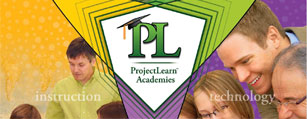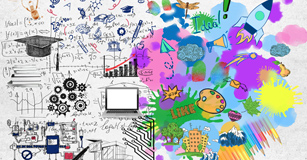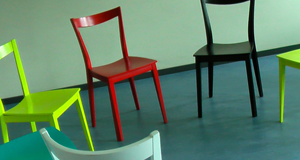Give Student Projects an Authentic Audience
Creating work that is worth seeing...and doing.

“What do you want to be when you grow up?”
The idea of “When I Grow Up” pervades our educational culture. Even in elementary school parent conferences, a child’s declaration to pursue a future profession is often one of the first things parents choose to share with teachers. Suzy wants to be a teacher, Joey wants to be an architect, and one out of a million children dream of making advances in string theory.
Yet, I would argue that the commonly held concept of “When I Grow Up” is a myth, a disengaged ideal from the actual childhood experience. This traditional educational paradigm might even be preventing our students from attaining the success and fulfillment the question is supposed to promote.
“When I Grow Up” inherently tells students that their value in the present is limited, that their ability to achieve or make a difference is governed by their age. “When I Grow Up” tells children that their work, their voice, and their identity do not matter as much as those of adults.
“What do you want to be today?”
Today.
Today is where childhood takes place. Feeling cold grass beneath bare feet. Licking the sweetness of the season’s first strawberries off of tiny fingers. Soaking in the charge of static electricity while sailing down the playground slide.
Today, Suzy is reading Junie B. Jones in front of the class for the first time. Today, Joey is designing a tower out of wooden blocks. Today, the one-in-a-million kid is performing a science experiment with corn starch and water. Today, our children are learning, but they are also “be-ing.” Suzy is a teacher, Joey is an architect, and every one of those million students are scientists.
If we believe that our students have potential beyond measure, then we must also act on those beliefs. We must provide opportunities for them to engage real-world problems in an environment where their solutions have the honest possibility of benefiting or even changing the world. If our students are engaging in and producing work that could actually benefit humankind, we have an imperative to showcase this work for authentic audiences. Not “when they grow up,” but now. Today.
Beyond waiting “To Grow Up”
For too long, our students have worked tirelessly for an audience of one: their teacher. When class assignments assume that work is simply preparation for some future “real world,” this singular audience makes sense. But in the course of a 21st century school year, if a class of students never produces anything worthy of being showcased for a real audience, the students’ potential has been both overlooked and under-realized.
Brilliant solutions to problems, insightful compositions, and entertaining performances are not unique to grown-ups. I have watched a fourth grader write a short novel that hit number seventy-five on an Amazon bestseller list, and a kindergartener execute a talent show performance that moved an audience to tears. In 2012, people across the nation marveled as 15-year old, Jack Andraka won the Intel International Science and Engineering Fair with research likely to revolutionize pancreatic cancer detection.
Each of these examples is the result of quality 21st century educational experiences… the result of experiences that allowed students to set personal goals, take ownership of their own progress, engage a real-world situation, and make an impact on a community significantly larger than an audience of one.
Examples of young success are not limited to a few “geniuses.” In many progressive educational environments, the success of our youth is no longer considered the exception, but the rule. Time and time again, our students are proving that there is something powerful about fresh, young eyes looking at a problem. Without giving all students the opportunity and empowerment (and expectation) to do more, the educational process serves simply as practice for the “real world” instead of recognizing that students are already part of it.
Work worth seeing is work worth doing
The use of critical thinking and creativity transforms traditional lessons into relevant, meaningful learning experiences. Both problem- and project-based learning allow students to create products and performances that demonstrate the knowledge acquired as well as celebrate students’ abilities to apply, analyze, evaluate, and synthesize their learning. Showcasing products and performances for peers, parents, and the community affirms both the value of the work and of the student.
Powerful interactions with real audiences allow students to receive honest feedback about their work and provide educators with an opportunity for authentic assessment. Effective methods for engaging authentic audiences for students abound:
- Presenting work to the school through class presentations or the school news show.
- Creating a whole-class History or Science Museum with displays, videos, and interactive exhibits.
- Presenting student projects by hosting a school- or community-wide Student Film Festival, Invention Convention, or Poetry Reading.
- Publishing print copies of student writing and illustrations through storyjumper.com or 48HrBooks.com.
- Submitting work to contests and competitions that allow students to have their work evaluated by an impartial panel of judges.
The process of developing an event or publication to showcase the work is often a rewarding learning experience itself.
Garnering a global audience
Technology makes it easy validate our students’ work by broadening the audience beyond the schoolhouse walls. A digital audience allows students to present their work to students around the world.
Lincoln Middle School students in Santa Monica, California have garnered over 570,000 views for their digitally-published collection of student-created math screencasts at Mathtrain.tv.
Whether you use it to share poems, photos, or podcasts, a class or school website is a great way to get started. Weebly and KidBlog provide easy-to-use platforms for posting and embedding student work. With the abundance of apps availabe today there is no need to wait until “When I Grow Up” to be a successfully published author, recording artist, or movie producer.
Today is “When I Grow Up”
A couple of years ago, several of my students entered an international Winter Story Competition. Motivated by a dynamic digital storytelling tool and the promise of an international audience, these budding authors spent hours writing, enhancing, and editing their stories.

Students across the globe read these stories, sharing their feedback and congratulations through the site’s online commenting system. The young runner-up received this comment: “I read all the stories in the contest and yours is the best! Be a writer when you grow up. You will be worldwide!” One comment like this, from an authentic global audience, has the power to significantly transform a student’s outlook on his or her future.
Soon after the deadline, we were notified that one of the fourth graders won the text-only competition and another was recognized as a runner-up in the illustrated division. Of course, as an international story contest winner at the age of 9, the young author of the story already is a writer… worldwide!
Today, our students are writers, are teachers, are architects, and are scientists. Today, our students are making mathematical discoveries, composing musical hits, and inventing viable solutions to everyday problems. What’s more, the world is an eager audience, awaiting the opportunity to glimpse our students’ greatness. Not “When They Grow Up,” but now.
Today.












